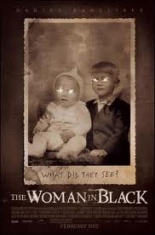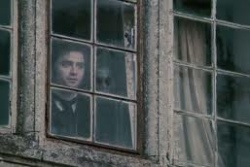
 Among the handful of movies released by the late-aughts-resurrected Hammer Films, The Woman in Black is the one that feels most like the old-school Hammer that film fans the world over hold near and dear to their hearts. (Let Me In, however, remains the best.) It’s low-key and Gothic, and relies little on special effects to get viewers scared.
Among the handful of movies released by the late-aughts-resurrected Hammer Films, The Woman in Black is the one that feels most like the old-school Hammer that film fans the world over hold near and dear to their hearts. (Let Me In, however, remains the best.) It’s low-key and Gothic, and relies little on special effects to get viewers scared.
Based upon a slim novel by Susan Hill that already earned an adaptation by British television in 1989, this new Woman has the fortunate status of having a leading man in Daniel Radcliffe, in his first post-Harry Potter role. You’ll quickly forget he was a boy wizard; here, he’s a lawyer and father of one little boy, and still grieving over the death of his wife during childbirth — so much so that he’s more than a tad suicidal.
 His employer sends him to one of those out-of-the-way villages where everybody knows about — but dare not go there, much less speak of — the mansion known as Eel Marsh House. His duty is to sort through the paperwork of its newly deceased owner so her will can be settled, but he spends more time investigating the expansive home’s strange noises and the fleeting appearance of the title character, whose visage fleets about his peripheral vision.
His employer sends him to one of those out-of-the-way villages where everybody knows about — but dare not go there, much less speak of — the mansion known as Eel Marsh House. His duty is to sort through the paperwork of its newly deceased owner so her will can be settled, but he spends more time investigating the expansive home’s strange noises and the fleeting appearance of the title character, whose visage fleets about his peripheral vision.
But not ours. Although used sparingly by director James Watkins (Eden Lake), the ghost gets right up in our faces to provide effective jolts in line with the recent Insidious, which also preferred practical effects over the all-too-easy (and all-too-artificial) computer-generated ones. That the specter at this film’s center has a rep for sending children to their death raises the stakes in an already eerie tale. Atmosphere abounds, expressing a visual chill to match the physical one moving up your spine. —Rod Lott
